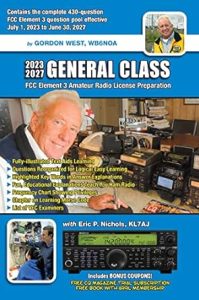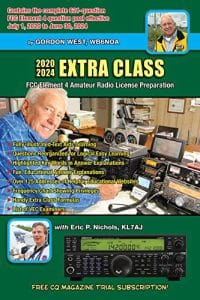You studied hard, found a test session (perhaps even with me at the San Francisco Radio Club VE Session) and got a new call sign, likely with a pretty “6” in it if you are local. Congratulations! You are now officially a Ham Radio Operator and part of the 0.01%...So…What’s next?
If you prefer to watch a video I have put one together for you below.
Here are a few things that can get you started:

Visit and Join your local club(s)
When first starting out, especially when on your own, joining one of or more of your local clubs is good first stop. You can find the list of San Francisco Bay Area Ham Radio Clubs here. Your local radio club, such as the San Francisco Radio Club, brings together like minded people with a common interest. It is a great place to get questions answered and to learn about new things from operating practices to DX expeditions, etc. as well as finding an Elmer/Mentor. If your are more a DX minded person in the bay area, such as myself, the NCDXC or Nothern California DX Club is a good one to visit and become a member of. For those interested in contesting the NCCC or Northern California Contest Club might be also worth looking into. I am personally a member of all three and there is a good chance of bumping into me at a meeting.
The San Francisco Radio Club meets monthly, every 3rd Friday except in December (Holiday Party) and meet in San Francisco. The Northern California DX Club meets every 3rd Thursday Except for July (Picnic) and December (Holiday Party) and meet in the south bay. The Northern California Contest Club moves their meetings around to accommodate all members. Please check the website for more info.
At these meetings you will find a warm and supportive environment, and we encourage you to attend as many as you like. You need not be a member, but you are welcome to join. Amateur Radio has a culture of information sharing and helping one another, so remember, every question is important. We all had the same questions once and someone was kind enough to assist us; we are hoping to return the favor. Joining and of these club does give you access to some members-only resources available on their website as well as a calendar filled with fun events, presentations and information to address your specific interests.
As an interesting side note:The San Francisco Radio Club is the oldest organization of its kind in the nation and has a rich history of community involvement, innovation in technology and especially fostering the newly licensed and those wanting to become HAMs.
Find an Elmer
And I guess that is where I as well as many current hams come in. So what is an elmer you ask? Basically a Mentor, but by Definition it is someone who provides personal guidance and assistance to would-be hams as well as those already licensed who may have some questions or need assistance in a given area. Amateur Radio can be technically challenging and intimidating at times and depending on how deep you dive into it, even complicated hobby. Personally I think that is half the fun. When you have someone to turn to with questions, the hobby is even more fun and rewarding…Enter the Elmer. Not to be confused with the Dragon of a similar movie title.
I have pretty much done a little bit of everything in ham radio at one time or another from ATV (aka Ham TV), DX-ing, antenna building, mobile setup, award hunting DXCC, WAS, VUCC, satellite work, extensive work in digital modes, CW, Computer integration, etc. While I don’t claim to be an expert in any one of these areas, whatever I know or have learned (Sometimes the hard way) I am happy to pass it on.
Join a Ham Radio Club

Listen to the repeaters in your area (or HF)
By monitoring local repeaters you will quickly learn the flow of communicating on 2m and above. In the San Francisco Bay Area 2m is by far the most active, so perhaps this is a good place to get started.
SIDE NOTE: You will also find activity on 70cm (440MHz) Digital and Analog Voice, 1.25m
(220MHz) pretty busy in some areas, generally lower power analog. Then there is 33cm (900MHz) Much of the hardware here is converted Motorola radios. The 23cm (1.2GHz) band is home to much of ATV as well as some digital voice. In addition 2.4GHz (mainly Data) and 10GHz (Line of Sight). Pretty much in that order of common usage. A radio that does 2m/70cm is a good start and is by far the most common combination.
2M Sutro Tower FM / Digital (AMS) : 145.150 MHz Offset: -600kHz DCS: 664
70CM VA Hospital FM/ Digital (AMS) : 444.225 MHz Offset: +5MHz PL: 114.8
W6PW- A/B/C/AD VA Hospital D-STAR
W6PW-C: 147.105MHz +600kHz
W6PW-B: 444.1625MHz +5MHz
W6PW-A: 1284.6GHz -12MHz
W6PW-AD: 1251.0MHz Simplex
If you are unsure of what the above means and/or how to set your radio, again your local club or Elmer (Including me) can be of assistance. Alternatively, you may look for model-specific info on the San Francisco Radio Club website.
Of course if your interests are also (or perhaps only) on HF, by all means tune in and observe even if you have not yet upgraded your license. You do not need a license to listen. You may find this a little more confusing at first as there are some inconsistencies from band to band, station to station and most contacts are rather short vs. those you find on 2M and above. A good place to start is 20m which is a band that is generally open throughout the year and at any given point of the solar cycle. Antenna requirements are not outrageous. A great nighttime band to start on is 40m, but this requires a larger antenna and it may not be feasible for all, especially if you reside in San Francisco. There are ways of doing this though…I would be happy to share some of these tricks at one of our meetings!
For local repeaters during morning and evening rush hour is a great time to monitor! For local repeater like LOCAL late night chatter, check out 40 and 80M. Once you listened, perhaps to both, you will find a pattern. As I had mentioned, you may also note that HF is quite different than your 2m rig when it comes to making contacts. Don’t let this discourage you, soon you will be talking “ham” in no time!
Buy your first radio & make a contact!
There are truly an overwhelming number of choices in radios not to mention prices are all over the place. HT (Portable Hand Held), mobile (can be used as base) or home base which are becoming less common now-a-days sadly. Then there is the question of 2M vs. All-band/mode, etc. how do you pick one? Again, this is something an Elmer would be more than happy to assist you with. There are many ways of going about this, many hams start with an HT as I did or Mobile unit which is very popular with those who have long commutes. Having a base station at your QTH (home operating position) is not something that is necessary but those especially with General and Extra licenses when working the HF bands prefer. Not unheard of someone working HF only on mobile. Get some personal recommendations on radios by talking to our club members, or ham radio store. If you’re shopping online (which you likely are), search and download the user manual for a few models to see if they fits your needs. As far as price, you generally do get what you pay for, BUT you may not need all the features therefore may not need to pay extra for them.
The “Big 3” are Yaesu, Icom and Kenwood which I would recommend for beginners. Some other brands of course like Alinco and some less expensive radios such as Baofeng, Wouxun, TYT which can be quite a challenge to program, even for seasoned hams, but there are videos on online which can assist as well as pretty good 3rd party documentation if you have your heart set on them or as simply limited with your budget. In addition, programming software (and programming cables) are becoming available that makes even the Chinese radios more user friendly as well as the “Big 3”. Check out RT Systems for more information as well as the manufacturer’s website!
Additionally, I would also recommend getting a few subscriptions to popular ham radio magazines such as “CQ” (Not to be confused with GQ….no relation) or “QST” which is included with your ARRL Membership if you so choose to join. I personally would highly recommend joining the ARRL for multiple reasons, but I will save that for another time. Those who want to read up on the magazine that got me interested was 73 Magazine and you can still get digital copies of it here.
Going to Ham Conventions, (Locally this would be Pacificon) is a great way also to get your hands on gear, view presentations, and meet other hams. Making your first contact can be very nerve-racking for many. But we have all been there at one time or another. But if you have been monitoring for a while now, surely you have some idea of where to get started. On 2M simply stating your call sign followed by “monitoring” works. The exception is satellite work when you state your grid square. Assuming you are not responding to another caller, on HF you will be calling CQ followed by your call sign. Suggested topics to chat about are: Location (QTH), Work, Weather, Traffic (Especially on mobile), Travel and of course the mandatory discussion of your (and their) ham gear antenna setup. Sometimes also referred to as the brag sheet.
Topics to avoid: Politics, Religion or anything that you may avoid discussion around the thanksgiving table to keep the peace. Keep jokes and language G rated. Not only a good practice but also an FCC rule.
Remember: You are on the air and many might be listening in, this is even truer on HF where the world might be listening. Nets are also a great way to get your feet wet. The San Francisco Radio Club has a net. It takes place every Monday evening at 8 on the 2 meter club W6PW Repeater on 145.15 MHz -600kHz offset DCS 664. All friends of the club are welcome. The location is Sutro Tower in the heart of the city, you do not have to be a member to participate. For those whose interests are more or also in HF, the San Francisco Radio Club also has a 20 Meter HF Club QSO Group Roundtable which takes place every Saturday morning at 9 on 14.328 MHz (+/-) In addition volunteering during special events sponsored by your club and/or field day are wonderful ways of getting started or getting some more practice in. The San Francisco Radio Club has a list of these posted on the website, it is updated regularly, please check them out. Don’t forget to Bookmark!
And of course there is Field Day. Even for veteran operators this is a great opportunity to operate under unique conditions, such as using a emergency power, portable rigs and antennas. Look for a “GOTA” (Get on the Air) Station to get your feet wet!
Explore upgrading your privileges
 It is possible that when you originally got your license, your primary interest was operating VHF/UHF or just simply getting your feet wet and seeing what this “ham thing” is all about. Perhaps you are still one of these folks if you are reading this. Well, I was one of these people myself, but quickly came to realize there is so much more to ham radio and by upgrading, new doors open which I never fully understood before. Looking back, I wish I had upgraded sooner myself. Trust me!
It is possible that when you originally got your license, your primary interest was operating VHF/UHF or just simply getting your feet wet and seeing what this “ham thing” is all about. Perhaps you are still one of these folks if you are reading this. Well, I was one of these people myself, but quickly came to realize there is so much more to ham radio and by upgrading, new doors open which I never fully understood before. Looking back, I wish I had upgraded sooner myself. Trust me!
Once you are ready to make the move, these are great resources (Images are links). For those looking to go beyond the general and all the way to the top with extra:
 There are also AUDIO CDs available from Gordon West for Extra Class test here and I highly recommend these! He also has these for General Class test here and for Technician Class test here as well.
There are also AUDIO CDs available from Gordon West for Extra Class test here and I highly recommend these! He also has these for General Class test here and for Technician Class test here as well.
The San Francisco Radio Club offers VE testing quarterly, or 4 times per year if you will. Testing usually starts at 8:30AM to 11:30AM in the same location as the club meetings.
For more information please see the website or to register and find more information about our testing program. If you have any questions regarding the Testing, you may also contact us via the website.





